Recent Advancements in Inertial Micro-Switches
Abstract
1. Introduction
2. Multi-Directional Inertial Micro-Switches
3. Multi-Threshold Inertial Micro-Switches
4. Persistent Closed Inertial Micro-Switches
5. Flexible-Electrode Inertial Micro-Switches
6. Low-g High-Threshold-Accuracy Inertial Micro-Switches
7. Current Challenges and Prospects
- (i)
- The contact effect of the Si-based switches is usually limited by the rigid electrodes. While the persistent closed switches can remain closed after the end of an acceleration pulse, they are usually hard or inconvenient to be reopened, resulting in inconvenience for some applications wherein repeated monitoring is needed.
- (ii)
- The multi-layer electroplating technology can enable the switch to have multiple sensitive directions or multiple threshold levels by fabricating multi-axial structures, or a reliable contact effect by fabricating flexible structures. However, it usually leads to a low threshold accuracy due to its inherent fabrication errors, especially in the case of low-g switches.
- (iii)
- While SOI technology can significantly improve the threshold accuracy of the inertial micro-switches, the high cost would hinder its applications.
Author Contributions
Funding
Conflicts of Interest
References
- Frobenius, W.D.; Zeitman, S.A.; White, M.H.; O’Sullivan, D.D. Microminiature ganged threshold accelerometers compatible with integrated circuit technology. IEEE Trans. Electron. Dev. 1972, 19, 37–40. [Google Scholar] [CrossRef]
- Loke, Y.; Mckinnon, G.H.; Brett, M.J. Fabrication and characterization of silicon micromachined threshold accelerometers. Sens. Actuators A Phys. 1991, 29, 235–240. [Google Scholar] [CrossRef]
- Currano, L.J.; Becker, C.R.; Lunking, D. Triaxial inertial switch with multiple thresholds and resistive ladder readout. Sens. Actuators A Phys. 2013, 195, 191–197. [Google Scholar] [CrossRef]
- Mcnamara, S.; Gianchandani, Y.B. LIGA fabricated 19-element threshold accelerometer array. Sens. Actuators A Phys. 2004, 112, 175–183. [Google Scholar] [CrossRef]
- Matsunaga, T.; Esashi, M. Acceleration switch with extended holding time using squeeze film effect for side airbag systems. Sens. Actuators A Phys. 2002, 100, 10–17. [Google Scholar] [CrossRef]
- Whitley, M.R.; Kranz, M.S.; Kesmodel, R.; Burgett, S.J. Latching Shock Sensors for Health Monitoring and Quality Control. In SPIE—MEMS/MOEMS Components and Their Applications II; International Society for Optics and Photonics: Bellingham, WA, USA, 2005; pp. 185–194. [Google Scholar] [CrossRef]
- Ongkodjojo, A.; Tay, F.E.H. Optimized design of a micromachined G-switch based on contactless configuration for health care applications. J. Phys. Conf. Ser. 2006, 34, 1044–1052. [Google Scholar] [CrossRef]
- Go, J.S.; Cho, Y.H.; Kwak, B.M. Acceleration Microswitches With Adjustable Snapping Threshold. In Proceedings of the International Solid-State Sensors and Actuators Conference-TRANSDUCERS ‘95, Stockholm, Sweden, 25–29 June 1995; pp. 691–694. [Google Scholar] [CrossRef]
- Noetzel, J.; Tønnesen, T.; Benecke, W.; Binder, J.; Mader, G. Quasianalog accelerometer using microswitch array. Sens. Actuators A Phys. 1996, 54, 574–578. [Google Scholar] [CrossRef]
- Selvakumar, A.; Yazdi, N.; Najafi, K. A wide-range micromachined threshold accelerometer array and interface circuit. J. Micromech. Microeng. 2001, 11, 118–125. [Google Scholar] [CrossRef]
- Currano, L.J.; Yu, M.; Balachandran, B. Latching in a MEMS shock sensor: Modeling and experiments. Sens. Actuators A Phys. 2010, 159, 41–50. [Google Scholar] [CrossRef]
- Dehkordi, S.H.; Moghadam, R.A.; Koohsorkhi, J. Design and simulation of bidirectional impact sensors array with optimized air damped response. Microsyst. Technol. 2015, 21, 247–254. [Google Scholar] [CrossRef]
- Lin, L.; Zhao, Q.; Yang, Z.; Zhang, D.; Yan, G. Design and simulation of a 2-axis low g acceleration switch with multi-folded beams. In Proceedings of the IEEE International Conference on Solid-state & Integrated Circuit Technology, Guilin, China, 28–31 October 2014. [Google Scholar]
- Greywall, D.S. MEMS-Based Inertial Switch. U.S. Patent 7,218,193, 15 May 2007. [Google Scholar]
- Sadashi, S. Acceleration Switch. U.S. Patent 8,772,656, 8 July 2014. [Google Scholar]
- Du, L.; Li, Y.; Zhao, J.; Wang, W.; Zhao, W.; Zhao, W.; Zhu, H. A low-g MEMS inertial switch with a novel radial electrode for uniform omnidirectional sensitivity. Sens. Actuators A Phys. 2018, 270, 214–222. [Google Scholar] [CrossRef]
- Zhanwen, X.; Ping, Z.; Weirong, N.; Liqun, D.; Yun, C. A novel MEMS omnidirectional inertial switch with flexible electrodes. Sens. Actuators A Phys. 2014, 212, 93–101. [Google Scholar] [CrossRef]
- Cao, Y.; Xi, Z.; Yu, P.; Wang, J.; Nie, W. A MEMS inertial switch with a single circular mass for universal sensitivity. J. Micromech. Microeng. 2015, 25, 105005. [Google Scholar] [CrossRef]
- Zhang, F.; Yuan, M.; Jin, W.; Xiong, Z. Fabrication of a silicon based vertical sensitive low-g inertial micro-switch for linear acceleration sensing. Microsyst. Technol. 2016, 23, 2467–2473. [Google Scholar] [CrossRef]
- Du, L.; Ming, Z.; Wang, A.; Chen, S.; Nie, W. Fabrication of novel MEMS inertial switch with six layers on a metal substrate. Microsyst. Technol. 2015, 21, 2025–2032. [Google Scholar] [CrossRef]
- Michaelis, S.; Timme, H.J.; Wycisk, M.; Binder, J. Acceleration threshold switches from an additive electroplating mems process. Sens. Actuators A Phys. 2000, 85, 418–423. [Google Scholar] [CrossRef]
- Li, K.; Chen, W.Y.; Zhang, W.P. Modeling of Beams’ Multiple-Contact Mode with an Application in the Design of a High-g Threshold Microaccelerometer. Sensors 2011, 11, 5215–5228. [Google Scholar] [CrossRef]
- Jia, M.; Li, X.; Song, Z.; Bao, M.; Wang, Y.; Yang, H. Micro-cantilever shocking-acceleration switches with threshold adjusting and ‘on’-state lathing functions. J. Micromech. Microeng. 2007, 17, 567–575. [Google Scholar] [CrossRef]
- Kim, H.S.; Jang, Y.H.; Kim, Y.K.; Kim, J.M. MEMS acceleration switch capable of increasing threshold acceleration. Electron. Lett. 2012, 48, 1614–1616. [Google Scholar] [CrossRef]
- Kim, H.S.; Jang, Y.H.; Kim, Y.K.; Kim, J.M. MEMS acceleration switch with bi-directionally tunable threshold. Sens. Actuators A Phys. 2014, 208, 120–129. [Google Scholar] [CrossRef]
- Younis, M.I.; Alsaleem, F.M.; Miles, R.; Su, Q. Characterization of the performance of capacitive switches activated by mechanical shock. J. Micromech. Microeng. 2007, 17, 1360–1370. [Google Scholar] [CrossRef] [PubMed]
- Erez, B.; Stella, L.; Slava, K. Design and implementation of a bistable force/acceleration sensing device considering fabrication tolerances. J. Microelectromech. Syst. 2018, 23, 1–12. [Google Scholar] [CrossRef]
- Ramini, A.; Younis, M.I.; Su, Q.T. A low-g electrostatically actuated resonant switch. Smart Mater. Struct. 2013, 22, 025006. [Google Scholar] [CrossRef]
- Yang, Z.; Ding, G.; Cai, H.; Xu, X.; Wang, H.; Zhao, X. Analysis and elimination of the ‘skip contact’ phenomenon in an inertial micro-switch for prolonging its contact time. J. Micromech. Microeng. 2009, 19, 045017. [Google Scholar] [CrossRef]
- Gerson, Y.; Schreiber, D.; Grau, H.; Krylov, S. Meso scale MEMS inertial switch fabricated using an electroplated metal-on-insulator process. J. Micromech. Microeng. 2014, 24, 405–412. [Google Scholar] [CrossRef]
- Currano, L.J.; Bauman, S.; Churaman, W.; Peckerar, M.; Wienke, J.; Kim, S.; Yu, M.; Balachandran, B. Latching ultra-low power mems shock sensors for acceleration monitoring. Sens. Actuators A Phys. 2008, 147, 490–497. [Google Scholar] [CrossRef]
- Xu, K.; Zhang, W.; Hao, Y. Mechanical latching stops for reliability improvement of MEMS in shock environments. Microsyst. Technol. 2018, 2, 3399–3407. [Google Scholar] [CrossRef]
- Ma, C.W.; Huang, P.C.; Kuo, J.C.; Kuo, W.C.; Yang, Y.J. A novel inertial switch with an adjustable acceleration threshold using an MEMS digital-to-analog converter. Microelectron. Eng. 2013, 110, 374–380. [Google Scholar] [CrossRef]
- Guo, Z.Y.; Zhao, Q.C.; Lin, L.T.; Ding, H.T.; Liu, X.S.; Cui, J.; Yang, Z.C.; Xie, H.K.; Yan, G.Z. An acceleration switch with a robust latching mechanism and cylindrical contacts. J. Micromech. Microeng. 2010, 20, 055006. [Google Scholar] [CrossRef]
- Guo, Z.Y.; Yang, Z.C.; Lin, L.T.; Zhao, Q.C.; Ding, H.T.; Liu, X.S.; Chi, X.Z.; Cui, J.; Yan, G.Z. Design, fabrication and characterization of a latching acceleration switch with multi-contacts independent to the proof-mass. Sens. Actuators A Phys. 2011, 166, 187–192. [Google Scholar] [CrossRef]
- Zhou, Z.J.; Nie, W.R.; Xi, Z.W.; Wang, X.F. Electrical contact performance of MEMS acceleration switch fabricated by UV-LIGA technology. Microsyst. Technol. 2015, 21, 2271–2278. [Google Scholar] [CrossRef]
- Dellaert, D.; Doutreloigne, J. A thermally-actuated latching MEMS switch matrix and driver chip for an automated distribution frame. Mechatronics 2016, 40, 287–292. [Google Scholar] [CrossRef]
- Sun, X.Q.; Zhou, S.; Carr, W.N. A surface micromachined latching accelerometer. In Proceedings of the International Solid State Sensors and Actuators Conference, Chicago, IL, USA, 19 June 1997; pp. 1189–1192. [Google Scholar] [CrossRef]
- Mehner, H.; Weise, C.; Schwebke, S.; Hampl, S.; Hoffmann, M. A passive microsystem for detecting multiple acceleration events beyond a threshold. Microelectron. Eng. 2015, 145, 104–111. [Google Scholar] [CrossRef]
- Zhao, J.; Jia, J.; Wang, H.; Li, W. A novel threshold accelerometer with postbuckling structures for airbag restraint systems. IEEE Sens. J. 2007, 7, 1102–1109. [Google Scholar] [CrossRef]
- Zhao, J.; Yang, Y.; Fan, K.; Hu, P.; Wang, H. A bistable threshold accelerometer with fully compliant clamped-clamped mechanism. IEEE Sens. J. 2010, 10, 1019–1024. [Google Scholar] [CrossRef]
- Hansen, B.J.; Carron, C.J.; Jensen, B.D.; Hawkins, A.R.; Schultz, S.M. Plastic latching accelerometer based on bistable compliant mechanisms. Smart Mater. Struct. 2007, 16, 1967–1972. [Google Scholar] [CrossRef]
- Gerson, Y.; Krylov, S.; Ilic, B. Electrothermal bistability tuning in a large displacement micro actuator. J. Micromech. Microeng. 2010, 20, 112001. [Google Scholar] [CrossRef]
- Tanner, J.D.; Jensen, B.D. Power-free bistable threshold accelerometer made from a carbon nanotube framework. Mech. Sci. 2013, 4, 397–405. [Google Scholar] [CrossRef]
- Gao, R.J.; Li, M.L.; Wang, Q.; Zhao, J.; Liu, S.T. A novel design method of bistable structures with required snap-through properties. Sens. Actuators A Phys. 2018, 272, 295–300. [Google Scholar] [CrossRef]
- Go, J.S.; Cho, Y.H.; Kwak, B.M. Snapping microswitches with adjustable acceleration threshold. Sens. Actuators A Phys. 1996, 54, 579–583. [Google Scholar] [CrossRef]
- Freudenreich, M.; Mescheder, U.; Somogyi, G. Simulation and realization of a novel micromechanical bi-stable switch. Sens. Actuators A Phys. 2004, 114, 451–459. [Google Scholar] [CrossRef]
- Sulfridge, M.; Saif, T.; Miller, N.; Meinhart, M. Nonlinear dynamic study of a bistable MEMS: Model and experiments. J. Microelectromech. Syst. 2004, 13, 725–731. [Google Scholar] [CrossRef]
- Sun, X.Q.; Farmer, K.R.; Carr, W.N. A bistable microrelay based on two-segment multimorph cantilever actuators. In Proceedings of the Eleventh Annual International Workshop on Micro Electro Mechanical Systems (MEMS 98. IEEE), Heidelberg, Germany, 25–29 January 1998; pp. 154–159. [Google Scholar] [CrossRef]
- Krylov, S.; Ilic, B.R.; Schreiber, D.; Seretensky, S.; Craighead, H. The pull-in behavior of electrostatically actuated bistable microstructures. J. Micromech. Microeng. 2008, 18, 55026. [Google Scholar] [CrossRef]
- Krylov, S.; Dick, N. Dynamic stability of electrostatically actuated initially curved shallow micro beams. Contin. Mech. Thermodyn. 2010, 22, 445–468. [Google Scholar] [CrossRef]
- Krylov, S.; Ilic, B.R.; Lulinsky, S. Bistability of curved microbeams actuated by fringing electrostatic fields. Nonlinear Dyn. 2011, 66, 403–426. [Google Scholar] [CrossRef]
- Medina, L.; Gilat, R.; Krylov, S. Symmetry breaking in an initially curved micro beam loaded by a distributed electrostatic force. Int. J. Solids Struct. 2012, 49, 1864–1876. [Google Scholar] [CrossRef]
- Medina, L.; Gilat, R.; Ilic, B.; Krylov, S. Experimental investigation of the snap-through buckling of electrostatically actuated initially curved pre-stressed micro beams. Sens. Actuators A Phys. 2014, 220, 323–332. [Google Scholar] [CrossRef]
- Medina, L.; Gilat, R.; Krylov, S. Latching in bistable electrostatically actuated curved micro beams. Int. J. Eng. Sci. 2017, 110, 15–34. [Google Scholar] [CrossRef]
- Medina, L.; Gilat, R.; Krylov, S. Sub g Threshold Acceleration Sensor Incorporating Latched Bistable Beam. In Proceedings of the ASME 2018 International Design Engineering Technical Conferences and Computers and Information in Engineering Conference, Quebec City, QC, Canada, 26–29 August 2018. [Google Scholar] [CrossRef]
- Yoo, K.; Park, U.; Kim, J. Development and characterization of a novel configurable MEMS inertial switch using a microscale liquid-metal droplet in a microstructured channel. Sens. Actuator A Phys. 2011, 166, 234–240. [Google Scholar] [CrossRef]
- Park, U.; Yoo, K.; Kim, J. Development of a mems digital accelerometer (MDA) using a microscale liquid metal droplet in a microstructured photosensitive glass channel. Sens. Actuators A Phys. 2010, 159, 51–57. [Google Scholar] [CrossRef]
- Liu, T.; Wei, S.; Tao, Y.; Yuan, X. Vibration interference analysis and verification of micro-fluidic inertial switch. AIP Adv. 2014, 4, 32–33. [Google Scholar] [CrossRef]
- Huang, Y.C.; Sung, W.L.; Lai, W.C.; Liu, C.Y.; Fang, W. Design and implementation of time-delay switch triggered by inertia load. In Proceedings of the IEEE 26th International Conference on Micro Electro Mechanical Systems, Taiwan, China, 20–24 January 2013; pp. 729–732. [Google Scholar] [CrossRef]
- Yang, Z.; Ding, G.; Chen, W.; Fu, S.; Sun, X.; Zhao, X. Design, simulation and characterization of an inertia micro-switch fabricated by non-silicon surface micromachining. J. Micromech. Microeng. 2007, 17, 1598–1604. [Google Scholar] [CrossRef]
- Cao, Y.; Xi, Z.; Yu, P.; Wang, J.; Nie, W. Optical Measurement of the Dynamic Contact Process of a MEMS Inertial Switch Under High Shock Loads. IEEE Trans. Ind. Electron. 2017, 64, 701–709. [Google Scholar] [CrossRef]
- Xu, Q.; Sun, B.; Li, Y.; Xiang, X.; Lai, L.; Li, J.; Ding, G.; Zhao, X.; Yang, Z. Design and characterization of an inertial microswitch with synchronous follow-up flexible compliant electrodes capable of extending contact duration. Sens. Actuators A Phys. 2018, 270, 34–45. [Google Scholar] [CrossRef]
- Li, J.; Wang, Y.; Li, Y.; Fu, B.; Sun, Y.; Yao, J.; Ding, G.; Zhao, X.; Yang, Z. A contact-enhanced MEMS inertial switch with electrostatic force assistance and multi-step pulling action for prolonging contact time. Microsyst. Technol. 2018, 24, 3179–3191. [Google Scholar] [CrossRef]
- Zhuoqing, Y.; Jianhao, S.; Jinyuan, Y.; Xiaojing, Z.; Guifu, D.; Xiaolin, Z. A laterally-driven mems inertial switch with double layers suspended springs for improving single-axis sensitivity. IEEE Trans. Compon. Packag. Manuf. Technol. 2018, 8, 1845–1854. [Google Scholar] [CrossRef]
- Chen, W.G.; Wang, Y.L.; Zhang, Y.H.; Cheng, P.; Wang, Y.; Ding, G.F.; Zhao, X.L.; Yang, Z.Q. Fabrication of a novel contact-enhanced horizontal sensitive inertial micro-switch with electroplating nickel. Microelectron. Eng. 2014, 127, 21–27. [Google Scholar] [CrossRef]
- Xu, Q.; Yang, Z.; Fu, B.; Li, J.; Zhao, X. A surface-micromachining-based inertial micro-switch with compliant cantilever beam as movable electrode for enduring high shock and prolonging contact time. Appl. Surf. Sci. 2016, 387, 569–580. [Google Scholar] [CrossRef]
- Peng, Y.C.; Wu, G.G.; Pan, C.P.; Lv, C.; Luo, T.H. A 5 g inertial micro-switch with enhanced threshold accuracy using squeeze-film damping. Micromachines 2018, 9, 539. [Google Scholar] [CrossRef]
- Field, R.V.; Epp, D.S. Development and calibration of a stochastic dynamics model for the design of a MEMS inertial switch. Sens. Actuators A Phys. 2007, 134, 109–118. [Google Scholar] [CrossRef]
- Hwang, J.; Ryu, D.; Park, C.; Jang, S.G.; Lee, C.I.; Kim, Y.K. Design and fabrication of a silicon-based MEMS acceleration switch working lower than 10 g. J. Micromech. Microeng. 2017, 27, 065009. [Google Scholar] [CrossRef]
- Zhang, F.; Wang, C.; Yuan, M.; Tang, B.; Xiong, Z. Conception, fabrication and characterization of a silicon-based MEMS inertial switch with a threshold value of 5 g. J. Micromech. Microeng. 2017, 27, 125001. [Google Scholar] [CrossRef]
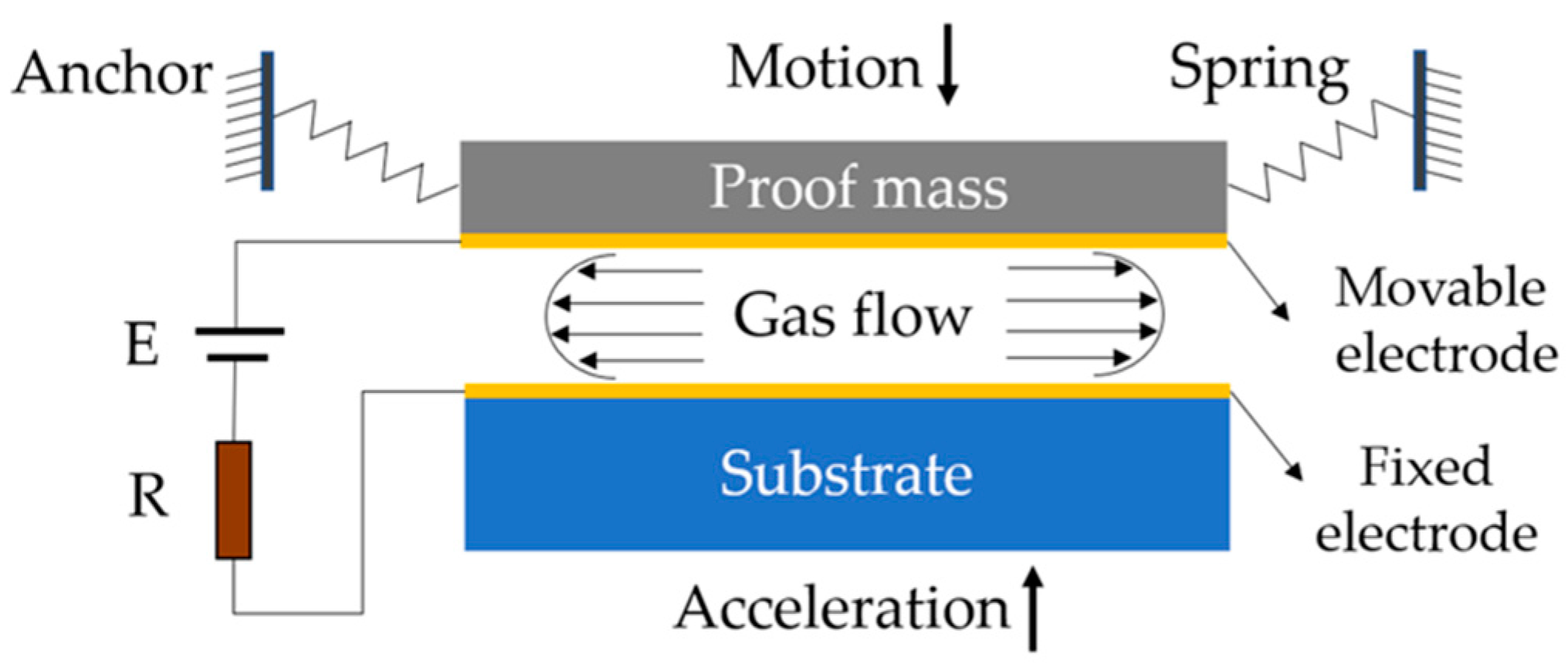
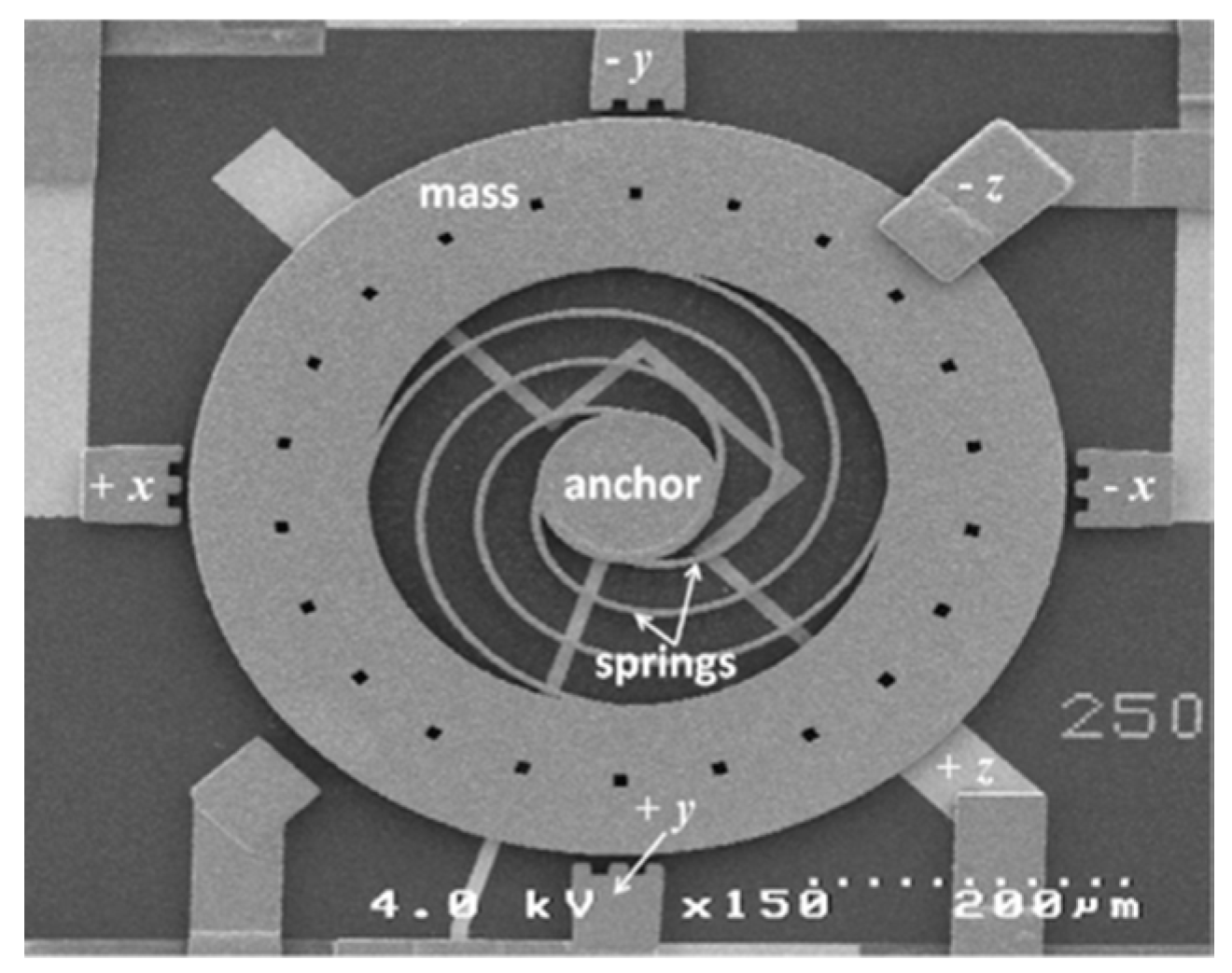
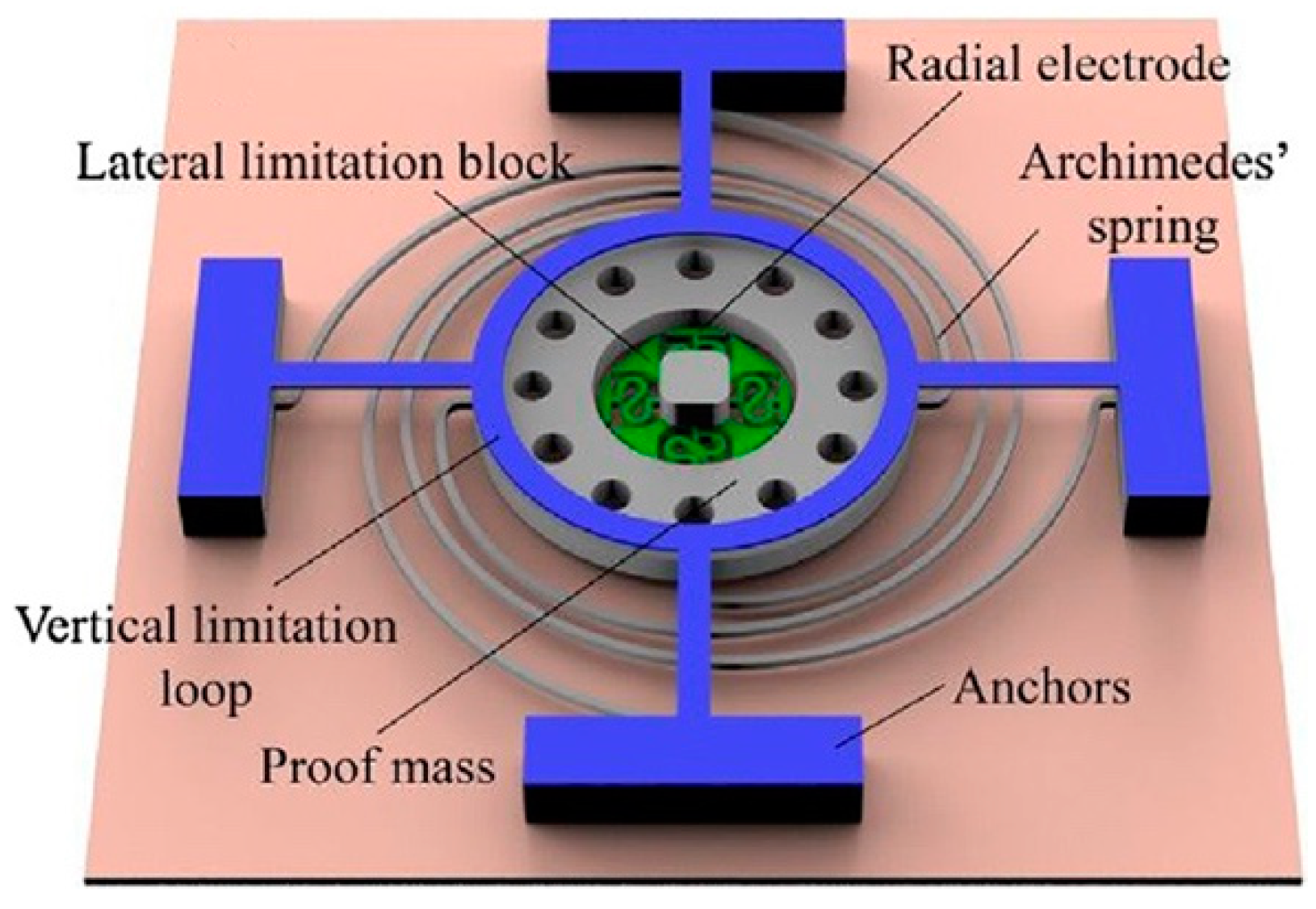
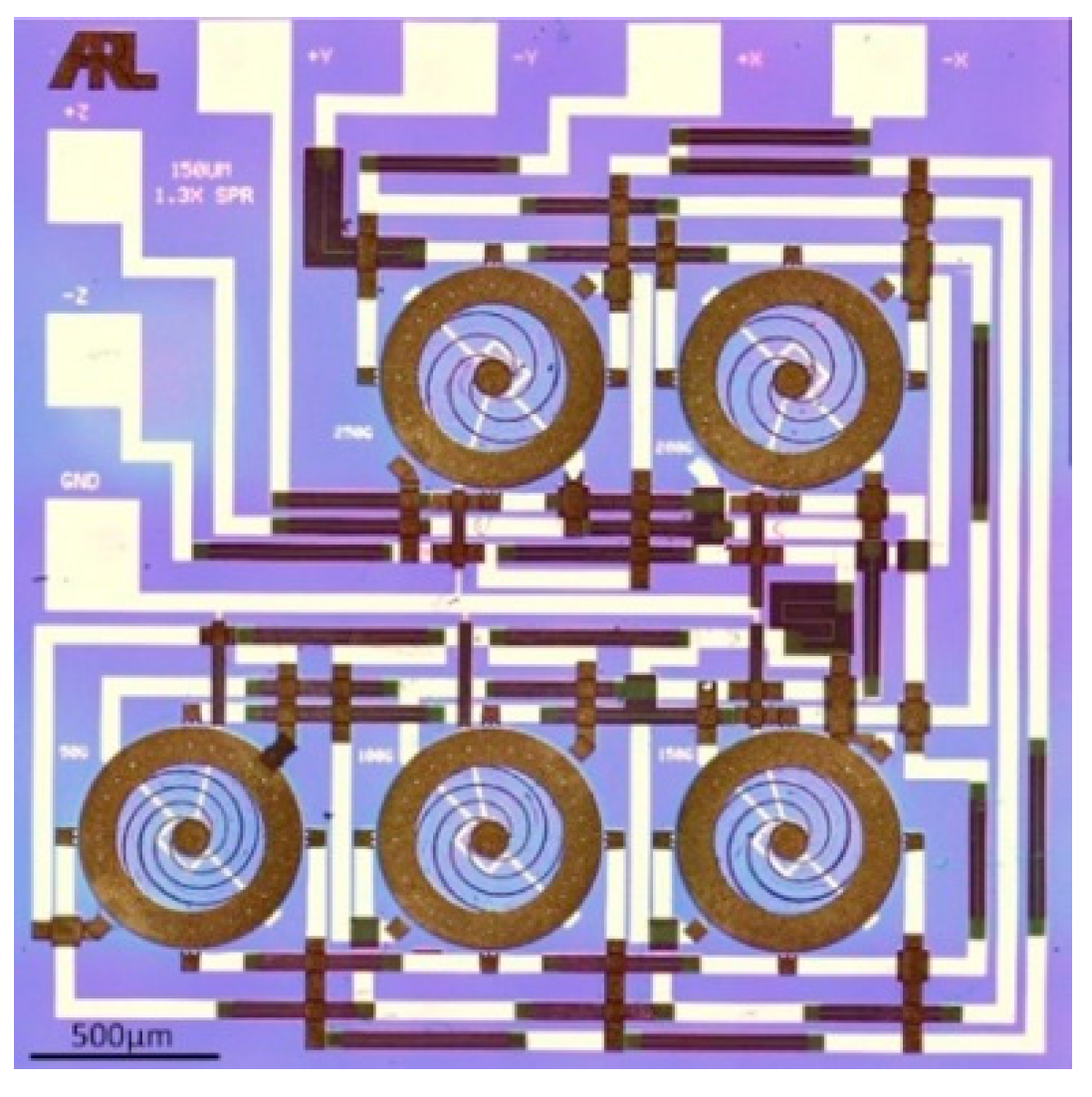
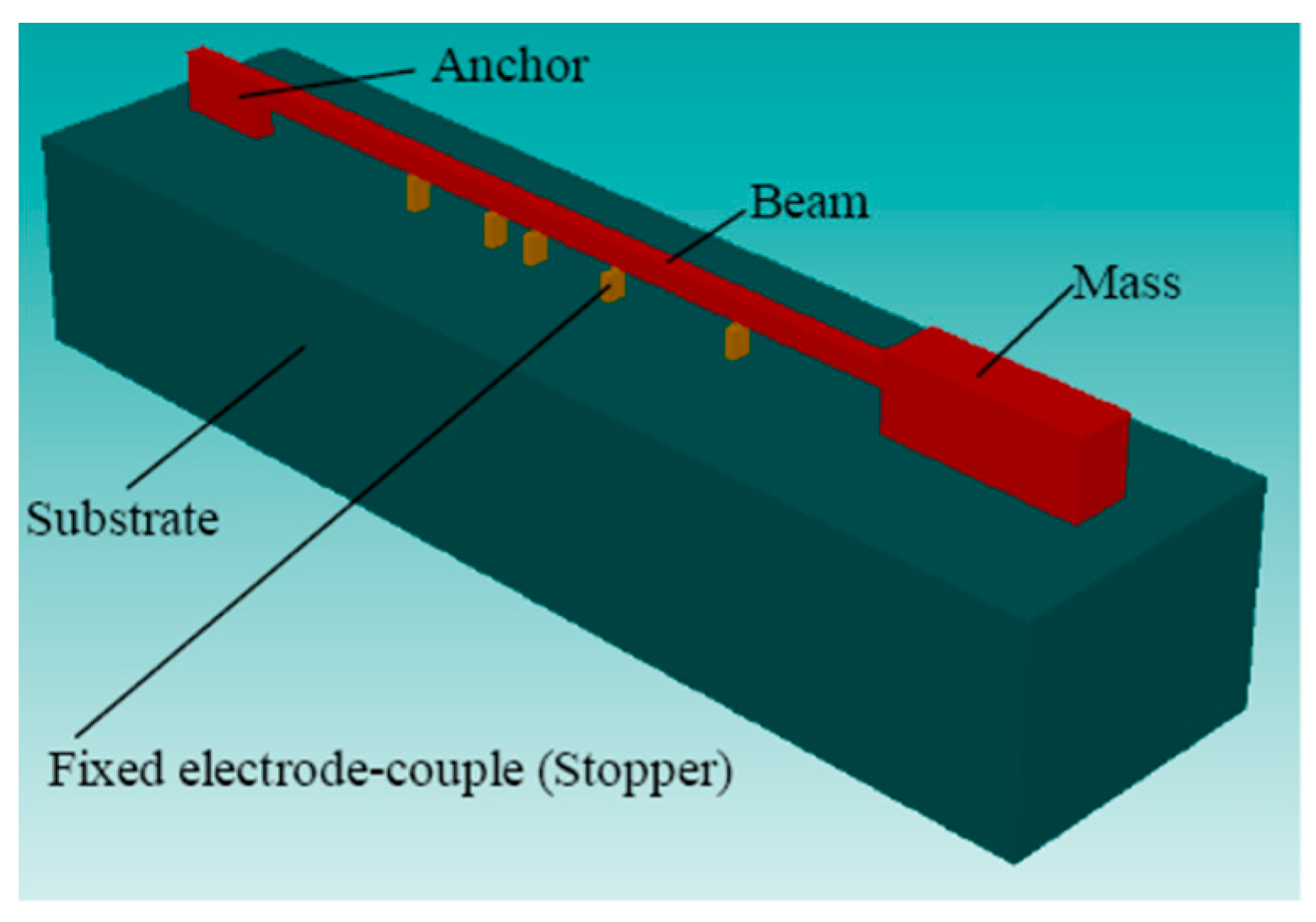
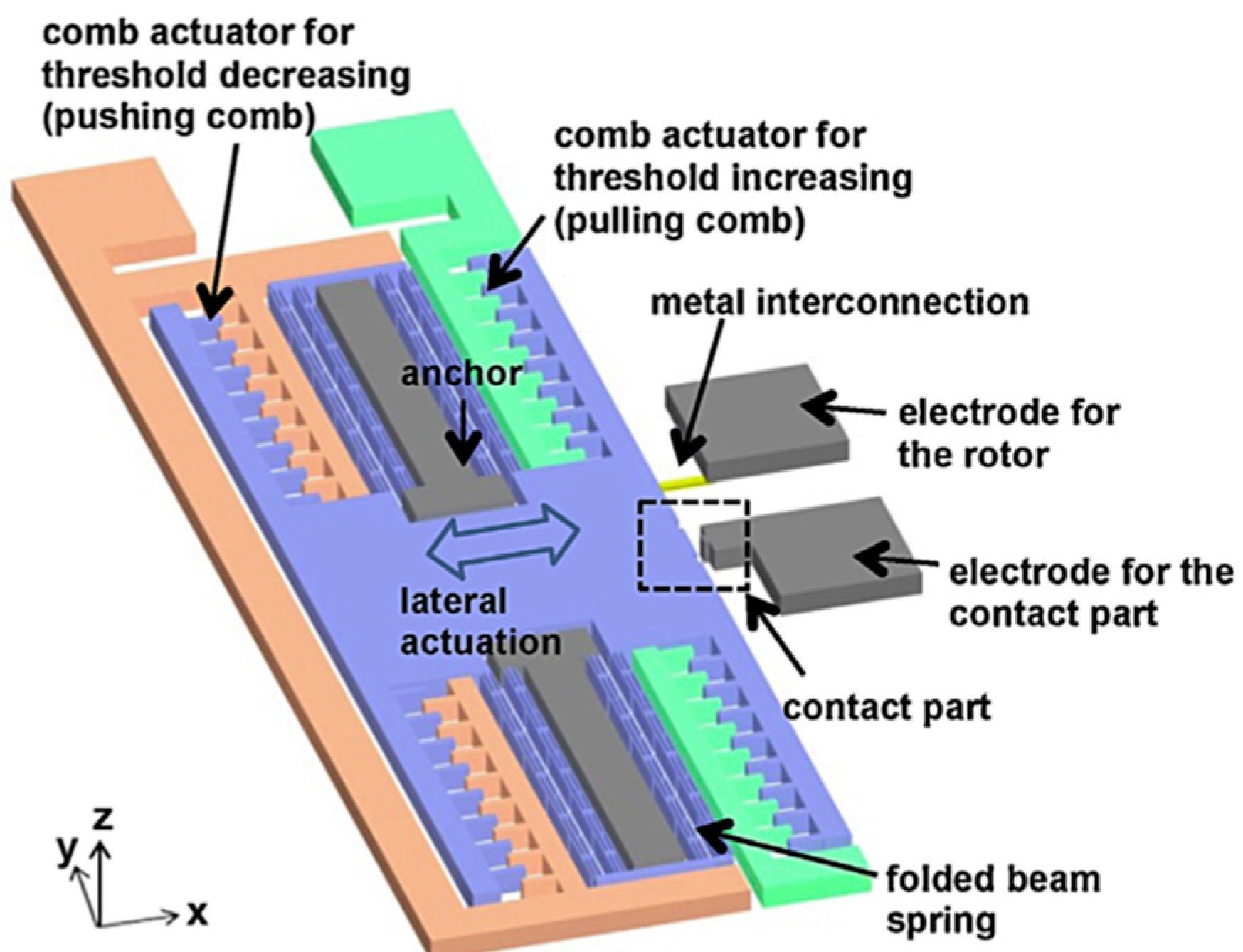
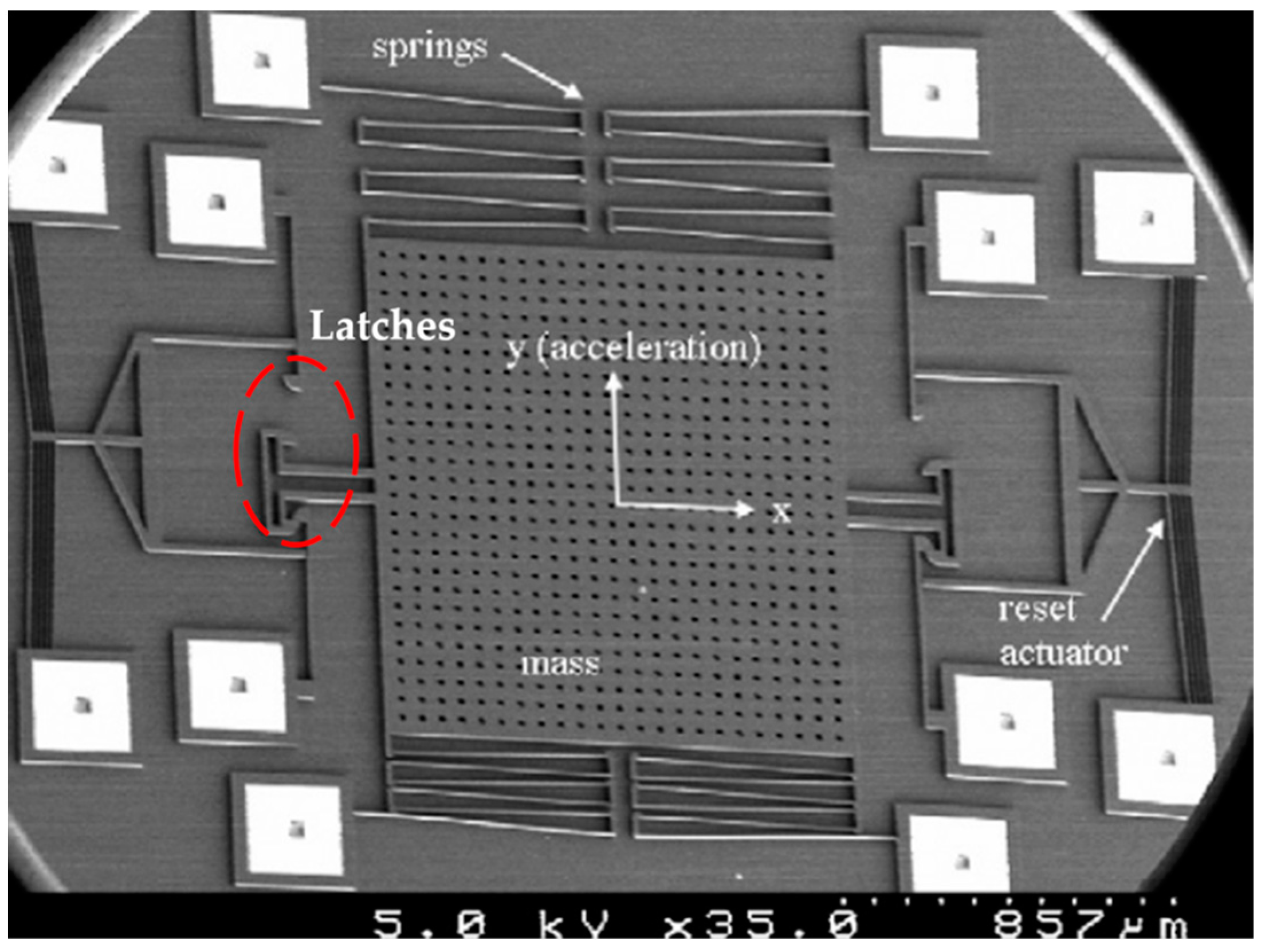

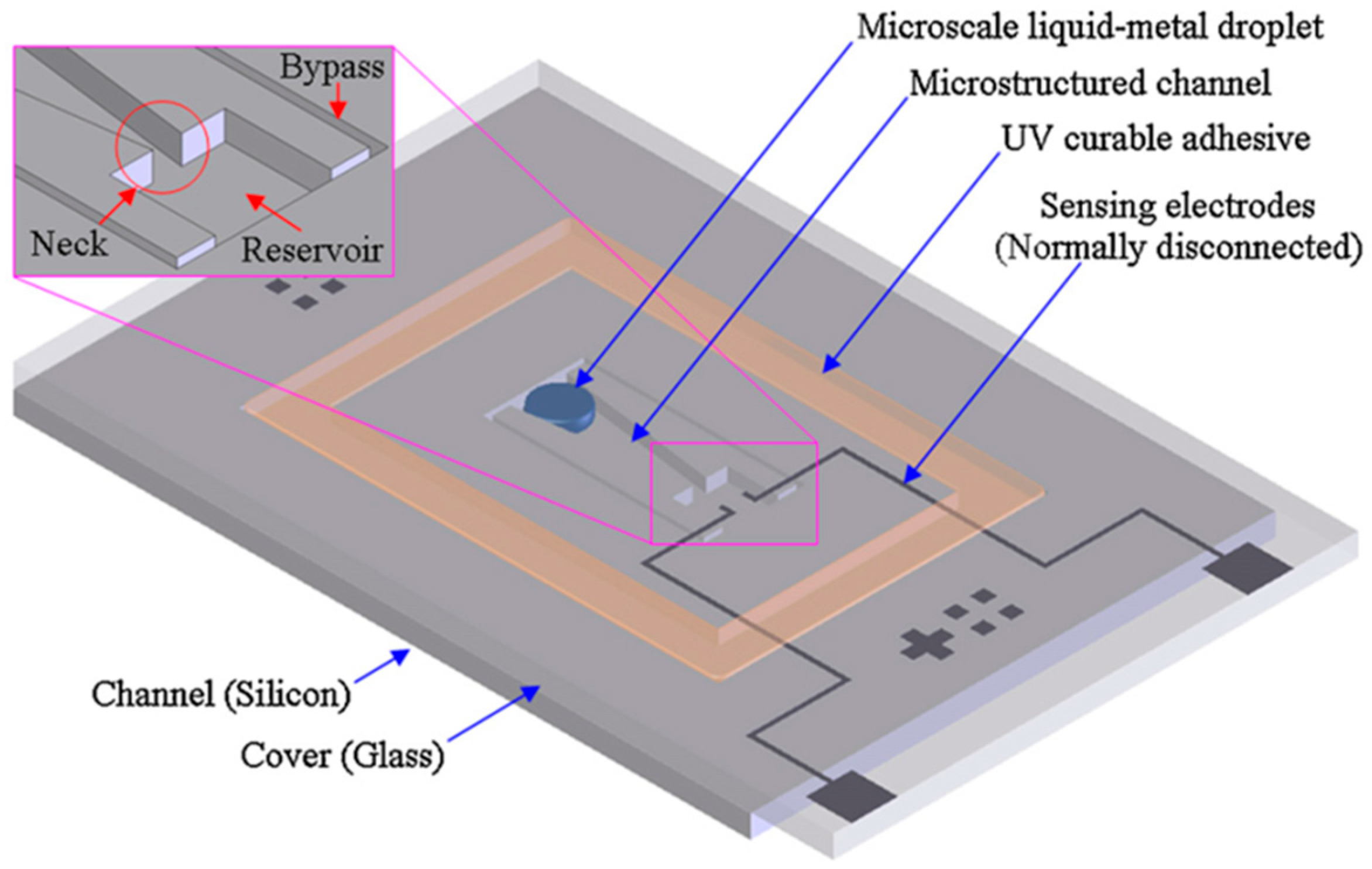
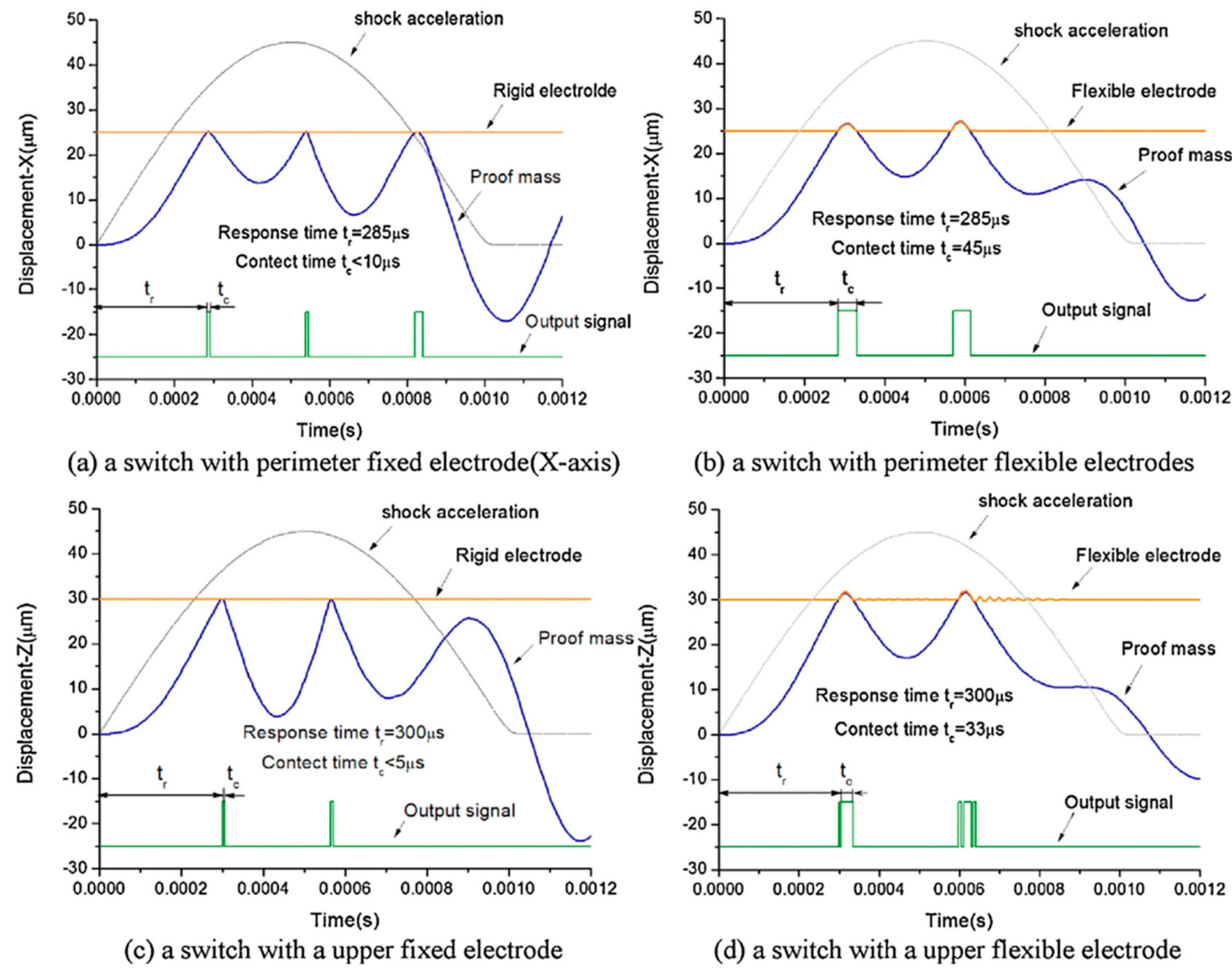
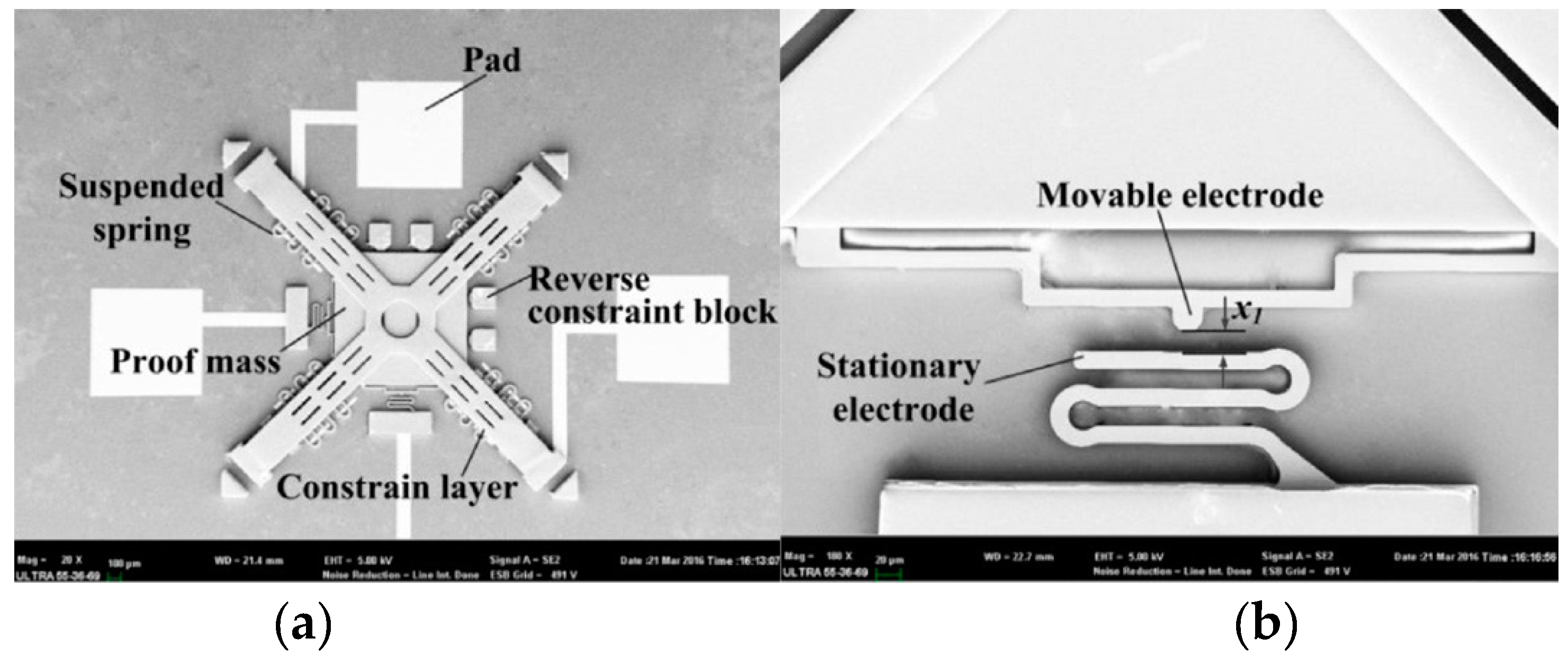
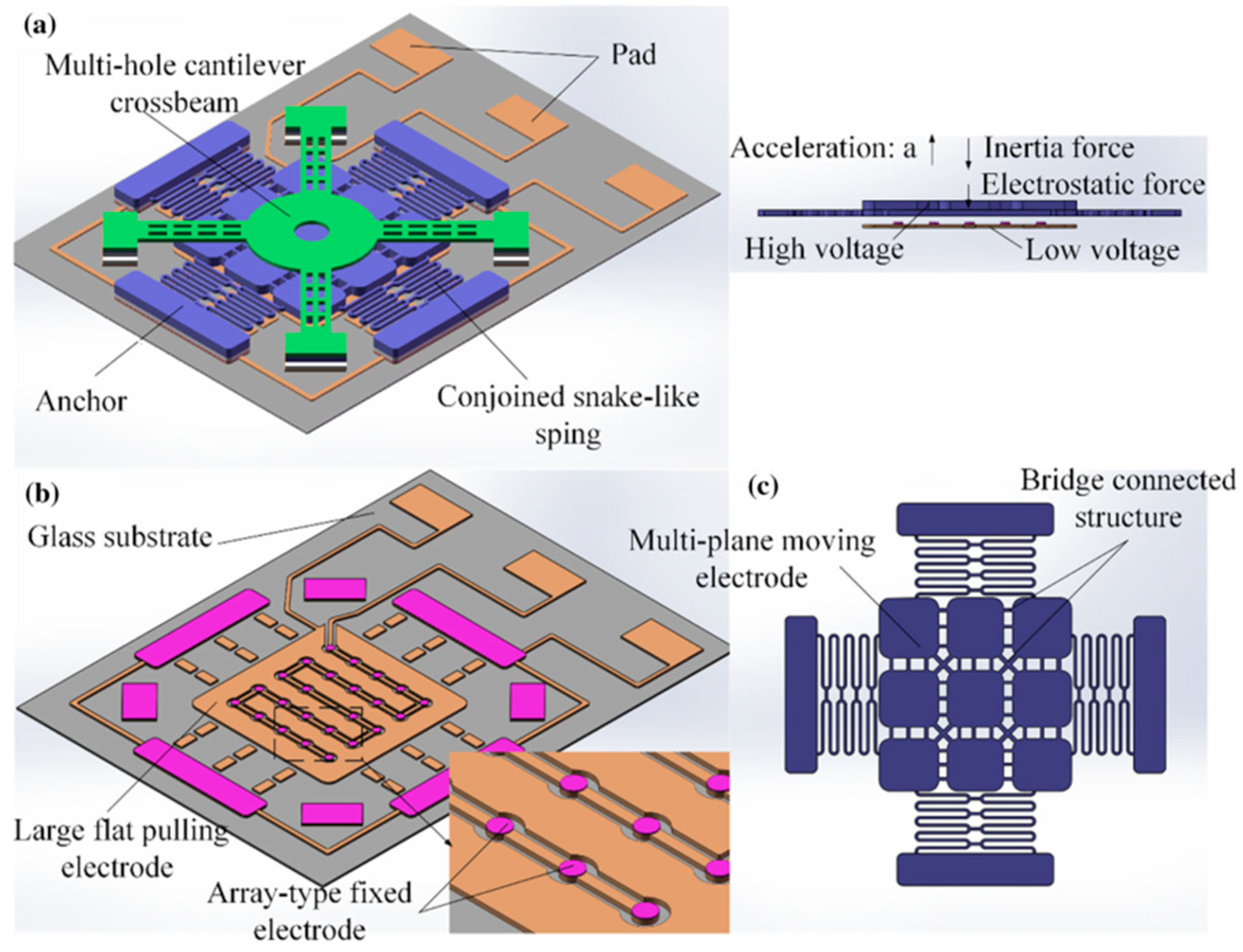
© 2019 by the authors. Licensee MDPI, Basel, Switzerland. This article is an open access article distributed under the terms and conditions of the Creative Commons Attribution (CC BY) license (http://creativecommons.org/licenses/by/4.0/).
Share and Cite
Peng, Y.; Sun, Y.; Luo, G.; Wu, G.; Zhang, T. Recent Advancements in Inertial Micro-Switches. Electronics 2019, 8, 648. https://doi.org/10.3390/electronics8060648
Peng Y, Sun Y, Luo G, Wu G, Zhang T. Recent Advancements in Inertial Micro-Switches. Electronics. 2019; 8(6):648. https://doi.org/10.3390/electronics8060648
Chicago/Turabian StylePeng, Yingchun, Yanling Sun, Guoxi Luo, Guoguo Wu, and Tao Zhang. 2019. "Recent Advancements in Inertial Micro-Switches" Electronics 8, no. 6: 648. https://doi.org/10.3390/electronics8060648
APA StylePeng, Y., Sun, Y., Luo, G., Wu, G., & Zhang, T. (2019). Recent Advancements in Inertial Micro-Switches. Electronics, 8(6), 648. https://doi.org/10.3390/electronics8060648




